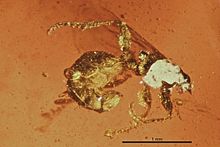Burmomyrma
|
Burmomyrma Temporal range: Late Aptian to Early Cenomanian |
|
|---|---|
 |
|
| Burmomyrma rossi holotype | |
| Scientific classification | |
| Kingdom: | Animalia |
| Phylum: | Arthropoda |
| Class: | Insecta |
| Order: | Hymenoptera |
| Family: | Formicidae |
| Subfamily: | Aneuretinae |
| Tribe: | incertae sedis |
| Genus: |
†Burmomyrma Dlussky, 1996 |
| Species: | †B. rossi |
| Binomial name | |
|
Burmomyrma rossi Dlussky, 1996 |
|
Burmomyrma is an extinct genus of ant in the formicid subfamily Aneuretinae, and is currently unplaced in the either of the tribes of that subfamily. The genus contains a single described species, Burmomyrma rossi. Burmomyrma is known from a single Middle Cretaceous fossil which was found in Asia.
Burmomyrma is known from a solitary adult fossil, the holotype, specimen number BMNH 19125. While the type specimen was collected in the early 1900s and deposited in the Natural History Museum in London, description of the specimen did not occur until nearly 80 years later. The holotype specimen is composed of a mostly complete dealate adult female which has been preserved as an inclusion in transparent chunks of deep yellow and relatively clear Burmese amber. The amber specimen was recovered from deposits in Kachin State of Myanmar. Burmese amber has been radiometrically dated using U-Pb isotopes, yielding an age of approximately 99 million years old, close to the Aptian – Cenomanian boundary.
The fossil was first studied by Russian paleoentomologist Gennady M. Dlussky of the Moscow State University. Dlussky's 1996 type description of the new genus and species was published in the Paleontological Journal. The genus name Burmomyrma is a combination of Burma, where the fossil was found, and the Greek myrmica which means "ant". The specific epithet rossi is a patronym honoring British paleoentomologist Andrew J. Ross.Burmomyrma is one of seven ant species described from Burmese amber; the others are Haidomyrmex cerberus, Haidomyrmex scimitarus, Haidomyrmex zigrasi, Myanmyrma gracilis, Sphecomyrmodes orientalis, and Zigrasimecia tonsora. The structures of the waist and wings lead Dlussky to tentatively place Burmomyrma in the subfamily Aneuretinae. Due to the incomplete nature of the fossil, the genus has not been assigned to either of the aneuretine tribes, being left incertae sedis. This placement has been followed by other authors, including in the 2003 family review by entomologist Barry Bolton. In a 2015 review of formicids, Brendon Boudinot noted that the features Dlussky listed for the inclusion of Burmomyrma in Aneuretinae are pleisiomorphic, being found in several ant subfamiles, and that placement of the genus into several other subfamiles is possible. However Boudinot did not make any taxonomic moves in the review, leaving the Aneuretinae placement stand at that time.
...
Wikipedia
